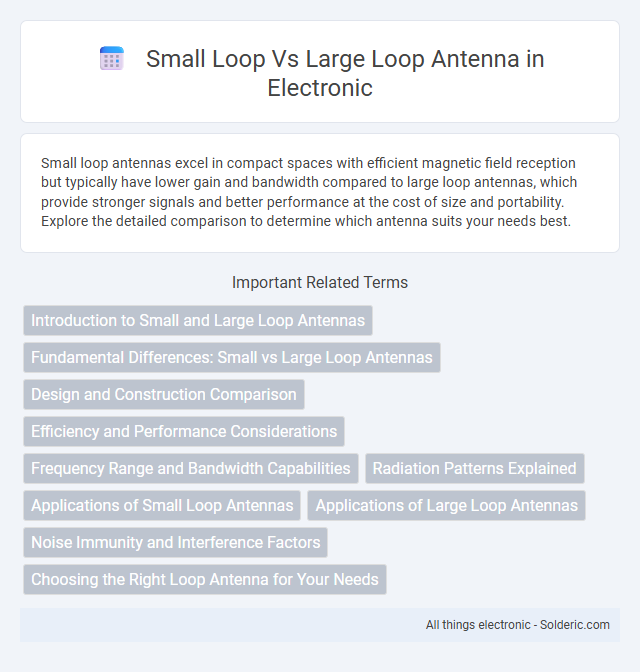Small loop antennas excel in compact spaces with efficient magnetic field reception but typically have lower gain and bandwidth compared to large loop antennas, which provide stronger signals and better performance at the cost of size and portability. Explore the detailed comparison to determine which antenna suits your needs best.
Comparison Table
| Feature | Small Loop Antenna | Large Loop Antenna |
|---|---|---|
| Size | Typically much smaller than wavelength | Comparable to or larger than wavelength |
| Efficiency | Lower due to high losses | Higher, better radiation efficiency |
| Bandwidth | Narrow bandwidth | Wider bandwidth |
| Radiation Pattern | Omnidirectional in plane of loop | Directional, figure-eight pattern |
| Impedance | Typically low and reactive | Higher, easier to match |
| Applications | Low-frequency reception, direction finding | Transmission, medium to high frequency communication |
| Construction Complexity | Simple, small size | More complex, larger size |
Introduction to Small and Large Loop Antennas
Small loop antennas feature a circumference much smaller than the operating wavelength, producing a primarily magnetic field with limited radiation efficiency but excellent noise rejection. Large loop antennas, with dimensions comparable to or larger than the wavelength, generate stronger electromagnetic fields and higher gain, improving signal transmission and reception. Your choice between small and large loop antennas depends on application requirements such as size constraints, operating frequency, and desired radiation pattern.
Fundamental Differences: Small vs Large Loop Antennas
Small loop antennas have circumferences much smaller than the operating wavelength, resulting in primarily magnetic field radiation with limited efficiency and narrow bandwidth. Large loop antennas, with circumferences comparable to or exceeding a wavelength, exhibit improved radiation efficiency, broader bandwidth, and significant electric and magnetic field components. The fundamental difference lies in size relative to wavelength, directly influencing radiation patterns, impedance characteristics, and overall antenna performance.
Design and Construction Comparison
Small loop antennas feature a compact design with a circumference significantly less than one wavelength, using thick conductors and often a single turn to minimize resistance and maximize efficiency. Large loop antennas approach or exceed one wavelength in circumference, employing multiple turns or larger diameters to enhance gain and bandwidth but requiring more complex construction and precise tuning. The small loop's simpler, lightweight frame contrasts with the large loop's heavier, more rigid structure, influencing installation and durability in various applications.
Efficiency and Performance Considerations
Small loop antennas exhibit lower efficiency due to their limited radiation resistance and higher relative losses compared to large loop antennas, which have greater radiation efficiency and improved signal strength. Large loop antennas provide better performance with enhanced bandwidth and stronger reception capabilities, making them ideal for applications requiring higher sensitivity. Your choice should balance size constraints against efficiency needs to optimize antenna performance.
Frequency Range and Bandwidth Capabilities
Small loop antennas typically operate effectively at lower frequencies with narrow bandwidths, making them suitable for VLF to HF bands but less efficient at higher frequencies. Large loop antennas provide broader bandwidth capabilities and can operate efficiently over a wider frequency range, often from MF through HF and sometimes into VHF. The difference in size directly impacts the resonance and radiation efficiency, with larger loops offering improved gain and wider tuning flexibility.
Radiation Patterns Explained
Small loop antennas exhibit a toroidal radiation pattern with nulls perpendicular to the loop plane and maximum radiation along the plane, making them ideal for direction finding and receiving signals with minimized noise. Large loop antennas produce more complex radiation patterns with multiple lobes and nulls, offering improved gain and directivity for transmission over longer distances. Your choice between small and large loops depends on the desired radiation pattern characteristics and application needs, such as signal strength and directional sensitivity.
Applications of Small Loop Antennas
Small loop antennas are widely used in applications requiring compact, directional sensing such as RF direction finding, electromagnetic field measurement, and AM broadcast reception. Their ability to operate efficiently at low frequencies makes them ideal for near-field communication systems and portable radio devices. Due to their low noise performance and high Q-factor, small loop antennas are favored in hobbyist and professional environments for signal detection and interference reduction.
Applications of Large Loop Antennas
Large loop antennas are widely used in low-frequency communication systems, including AM radio broadcasting and maritime communication, due to their efficient radiation patterns and ability to cover longer distances. They serve critical roles in direction finding and electromagnetic compatibility testing because of their enhanced signal reception and noise suppression capabilities. Your communication setup benefits from large loop antennas when requiring reliable performance over extended ranges and in complex electromagnetic environments.
Noise Immunity and Interference Factors
Small loop antennas exhibit superior noise immunity compared to large loop antennas due to their reduced susceptibility to electric field interference and lower capacitive coupling. Large loop antennas can pick up more ambient noise and electromagnetic interference because of their greater surface area, which acts like a larger antenna for unwanted signals. Your choice between small and large loops should consider the operating environment, where small loops often provide clearer reception in urban or high-interference areas.
Choosing the Right Loop Antenna for Your Needs
Small loop antennas offer compact design and high selectivity, making them ideal for portable or space-constrained applications, while large loop antennas provide greater efficiency and improved signal strength suitable for stationary use and long-distance reception. Your choice depends on factors such as available installation space, desired frequency range, and signal quality requirements. Evaluating these considerations ensures optimal performance tailored to your specific antenna needs.
small loop vs large loop antenna Infographic

 solderic.com
solderic.com